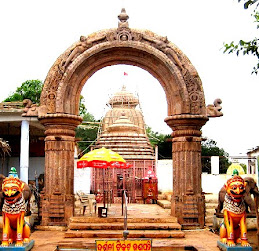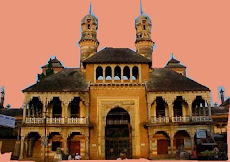Governor Murlidhar Chandrakant Bhandare on July 24 appointed new Vice-Chancellor for Berhampur University. Professor Jayant Mohapatra, who is registrar of Berhampur University, would replace outgoing Vice-Chancellor Prof. B. K. Sahu whose tenure is ending on July 26. “Prof Mohapatra has been appointed for a period of three years. He is heading Department of Political Science of the university. Besides, he has assumed responsibilities in different capacities,” said a release issued by Raj Bhawan. It said the 52-year-old political science professor was an assessor of NAAC, Bangalore. According to the release, he had guided 13 scholars on various research projects producing 12 Ph.Ds. Transparency in administration will be my top priority. Emphasis will be given on quality education, said Prof. Mohapatra while speaking to mediapersons.
Saturday 24 July 2010
Thursday 22 July 2010
Students’ body battles for HC bench in Berhampur
Permanent bench of High court in Berhampur demanded
BERHAMPUR: South Orissa Students' Association (SOSA) has expressed its solidarity with the agitating lawyers of South Orissa and has demanded early establishment of a permanent bench of Orissa High court at Berhampur- the nerve centre of activities in southern part of the State. SOSA president RP Tripathy said southern Odisha has remained the forgotten frontier of the State with alarming levels of poverty and underdevelopment. While majority people of South Odisha are living under abject poverty and backwardness their genuine demands have been repeatedly overlooked by the state government. The students' body pointed out that lawyers had been demanding establishment of a High Court bench in the city for the past six decades. Both the lawyers and general public of south Orissa have resorted to agitations for this demand in the past. The SOSA activists urged the lawyers in Cuttack, especially the ones of the Orissa High Court, to get out of their insensitiveness towards the problems of people from far off areas to approach the High Court located in Cuttack. It may be noted that the Bar Association of the Orissa High Court and the Cuttack Bar Association boycotted courts on Monday to protest against the statement of Union Law Minister Veerappa Moily in favour of the establishment of High Court benches in Orissa during his visit to Sambalpur. The SOSA activists through a press release expressed surprise that how delivering justice at the doorstep of the poor through benches of the High Court could be opposed by them. They pointed out that former President of India V.V. Giri and former Chief Minister of Orissa Biju Patnaik had openly supported the demand for establishment of High Court bench in Berhampur. They alleged that delay in establishment of permanent benches of the High Court in parts of the state was depriving people of south Orissa their right to get justice at their doorstep.
While recommending a High Court Bench at Berhampur in 2007, the State government opined that there was an urgent need for this in view of the backwardness of the region, popular mood and large number of cases originating from here. As per SOSA, cases from south Orissa constitute more than 30 per cent of the total cases in the Orissa High Court. The geographical spread of south Orissa makes the need of a High Court bench in Berhampur an inevitable one. They said that Berhampur had all necessary infrastructure for the establishment of a permanent bench of the High Court and it was well connected to all parts of south Orissa. The SOSA urged the lawyers of the Orissa High Court to give up stubbornness and support the demand for the interest of the general public. They urged the Union Law Ministry and the State government to expedite the process of establishment of High Court benches in the State.
Sources: The Pioneer, The Hindu, OrissaDiary, KalingaTimes, OrissaBarta
Sunday 18 July 2010
Ganjam Bar decries Cuttack Highcourt lawyers’ move
Berhampur: The Ganjam Bar Association, Berhampur on July 18 after an emergency meeting condemned the action of Cuttack Highcourt bar following the statement of Union Law Minister regarding establishment of benches in the State other than the principal location.
Ganjam Bar, in the meeting, had welcomed the decision of Union Law Minister Veerappa Moily who had opined in favour of establishment of benches of High Court at places other than the principal seat. However, it was regretted as the Union Minister had forgotten the stand of Ganjam Bar Association that has been demanding a permanent HC bench at Berhampur for decades. Berhampur happens to be the most suitable place for the establishment of a permanent bench of the high court, stated former secretary of the Ganjam Bar, Manoj Patnaik.
Besides, it was also decided that the bar association would again gather all the office-bearers of the bar association across south Odisha for intensification of the movement in favour of HC bench at Berhampur. The bar association also condemned the action of the Cuttack bar that has taken the decision to oppose the Law Minister’s move.
Source: The Pioneer
Wednesday 14 July 2010
Thousands of devotees witness Rath Yatra at Sabara Srikhetra Koraput
- Tribal band and dance add to the attraction
- Tribals are given priority in the Rath Yatra celebrations at Koraput
KORAPUT: More than 50,000 people, including tribals, gathered to celebrate this year's car festival at Sabara Srikhetra (Koraput) in South Orissa on July 13. Better known as Sabara Srikhetra, among the followers of Jagannath culture, Koraput has been attracting the tribals for its unique distinction in giving priority to tribals in its rituals and practices.
Beginning with the offering of service to Lord Jagannath, Balabhadra and Subhadra during Anasara, a period when the Lords are believed to be suffering from fever after a bath on Snaana Purnima, tribals have been in the forefront in taking responsibilities and enjoying the opportunities during the nine-day festival.
It is again the tribal band and dances that lent special attraction to the celebration. Tribal men and women had reached the temple from early morning to have a glimpse of Lord Jagannath. They were the most active participants in preparing the costumes including the tahia and other aids to add more beauty to the idols.
After the Lords reached the divine chariot, offerings from tribals were placed first. More than 50 tribal village heads were honoured by the district Collector and SP by tying turbans over their heads. Tribal village head Dasi Nayak from Janiguda near Koraput performed the divine sweeping on the chariot, a service that is offered by the king at Puri.
Source: The Hindu
Tradition lives on at Marda Jagannath temple near Berhampur in Ganjam
- Lord Jagannath, Balabhatra and Devi Subhadra of Puri were kept here for two years to protect them from Mughal invaders
- To this day, no deity has been kept at the Marda temple
- Devotees throng the temple though no Rath Yatra is organised here
 Hundreds of devotees thronged the ‘Jagannath temple' at Marda near Berhampur city in Ganjam district although no Rath Yatra was held here.
Hundreds of devotees thronged the ‘Jagannath temple' at Marda near Berhampur city in Ganjam district although no Rath Yatra was held here.The people who visited Marda on July 13 had reached there to spend a day with the history related to Lord Jagannath. The temple at Marda has no deity but it depicts an important chapter of Oriya history. The deities of Jagannath temple in Puri were concealed here for more than two years to avoid sacrilege at the hands of Mughal invaders in the 18th century. The then king of Athagadapatna, Jagannath Harichandan had built up this rock temple for the deities. Even after the deities returned to Puri in 1736, Harichandan had preferred to keep the temple without deity to preserve the memory of this great event.
The visitors included people from different parts of Orissa as well as from near by Patahara village. The ancestors of inhabitants of Pathara village had built up the temple at Marda in a few months. Till now some families of Pathara are involved in stone carving. Unlike other temples even on the day of Rath Yatra no traditional musical instruments are played in this temple.
During the sojourn of the deities at this temple sound of these instruments was avoided to keep the temple hidden from the eyes of Mughal spies. The tradition lives on.
Source : The Hindu
Subscribe to:
Posts (Atom)


























